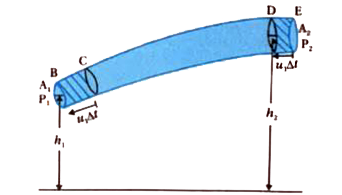Prove Bernoulli 's Principle . OR Obtain Bernoulli's equation for steady incompressible irrotational and viscous liquid.Solution in Gujrati
A pipe is shown in figure.
At point B of left end of pipe Fluid speed =v1
Cross sectional area =A1.
Pressure exerted on fluid P1=F1A1.

At point D , of right end of pipe ,
Fluid speed =v2
Cross esctional area =A2
Pressure exerted on the fluid P2=F2A2.
Force F1=P1A1 exerted on fluid at point B, covers distance v1Δt and reaches at point C. the work done on fluid
W1= (Force)(displacement)
W1=P1A1v1Δt
∴W1=P1(ΔV1) ....(1)
where ΔV=A1v1Δt= volume of fluid)
Fluid at point d, covers distance v2Δt and reaches at point E, the work done by the fluid.
W2=−P2A2v2Δt
∴W2=−P2ΔV ....(2)
where ΔV=A2v2Δt= volume of fluid)
According to equation of continuity both fluids have same volume.
Total work done on the fluid
W=W1+W2
W=P1ΔV−P2ΔV
W=(P1−P2)ΔV ....(3)
Part of this work goes into changing the kinetic energy of the fluid and part goes into changing the gravitational potential energy.
W=ΔK+ΔU .... (4)
The mass flowing fluid of density ρ at time Δt.
Δm=Volume×Density
Δm=ρ(ΔV) ...(5)
This liquid when moves from B to D its velocity becomes v1 to v2 . Hence change in its kinetic energy
ΔK=12m(v22−v21)
ΔK=12ρΔV(v22−v21) .....(6)
When fluid of mass Δm move from B to D , it posses height from h1 to h2(h2>h1) . Hence its potential energy is botained as below
ΔU=mg(h2)−mg(h1)
ΔU=mg(h2−h1)
ΔU=(ρΔV)g(h2−h1) ....(7)
The values of W , ΔK,ΔU in equation (4) from equation (3),(6),(7)
(P1−P2)ΔV=12ρΔV(v22−v21)+(ρΔV)g(h2−h1)
Dividing each by ΔV
P1−P2=12ρ(v22−v21)+ρgh2−h1)
∴P1−P2=12ρv22−12ρv21+ρgh2−ρgh1
∴P1+12ρ21+ρgh1=P2+12ρv22+ρgh2 ....(8)
Equation (8) is called Bernoulli.s equation In general
P+12ρv2+ρgh= constant ....(9)
In words the Bernoulli.s equation may be stated as follows :
As moving along a streamline the sum of the pressure (P) , the kinetic energy per unit volume
(12ρv2) and the potential energy per unit volume (ρgh) remains a constant.
Topper's Solved these Questions
- MECHANICAL PROPERTIES OF FLUIDS Book:KUMAR PRAKASHANChapter:MECHANICAL PROPERTIES OF FLUIDS Exercise:SECTION-A Try Yourself (VSQs)
Explore 132 Videos
- MECHANICAL PROPERTIES OF FLUIDS Book:KUMAR PRAKASHANChapter:MECHANICAL PROPERTIES OF FLUIDS Exercise:SECTION - B Numericals
Explore 29 Videos
- MACHANICAL PROPERTIES OF SOLIDS Book:KUMAR PRAKASHANChapter:MACHANICAL PROPERTIES OF SOLIDS Exercise:QUESTION PAPER
Explore 11 Videos
- MOTION IN A STRAIGHT LINE Book:KUMAR PRAKASHANChapter:MOTION IN A STRAIGHT LINE Exercise:QUESTION PAPER
Explore 11 Videos
Similar Questions
What is fluid ?
View SolutionA 14.5 kg mass, fastened to the end of a steel wire of unstretched 1.0 m, is whirled in a vertical circle with an angular velocity of 2 rev/s at the bottom of the circle. The cross- sectional area of the wire is 0.065 cm2. Calculate the elongation of the wire when the mass is at the lowest point of its path.
View SolutionWhat is called brittle material ?
View SolutionDefine frame of reference and give its types.
View SolutionBernoulli's equation for steady, non-viscous, imcompressible flow expresses the
View SolutionBernouli's equation for a steady streamline flow of a non-viscous incompressible fluid expresses the principle of
View SolutionState and prove Bernoulli's theorem for a flow of incompressible, non-viscous, and streamlined flow or fluid.
View SolutionState and prove Bernoulli's theorem for a flow of incompressible, non-viscous, and streamlined flow or fluid.
View SolutionState and prove Bernoulli's theorem for a flow of incompressible, non-viscous, and streamlined flow or fluid.
View SolutionA: Bernoulli's theorem holds good only for non viscous and incompressible liquid.
R: Bernoulli’s theorem is based on the conservation of energy
View SolutionState and prove Bernoulli's theorem for a flow of incompressible, non-viscous, and streamlined flow or fluid.
View SolutionBernoulli's equation for steady, non-viscous, incompressible flow expresses the:
View SolutionFor a uniform flow of an incompressible, non-viscous fluid the Bernoulli's theorem expresses,
View SolutionState and prove Bernoulli's theorem for a flow of incompressible, non-viscous, and streamlined flow or fluid.
View SolutionState and prove Bernoulli's theorem for a flow of incompressible, non-viscous, and streamlined flow or fluid.
View Solution

